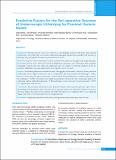Please use this identifier to cite or link to this item:
https://hdl.handle.net/20.500.14356/982Full metadata record
| DC Field | Value | Language |
|---|---|---|
| dc.contributor.author | Mishra, Udita | - |
| dc.contributor.author | Shrestha, Anil | - |
| dc.contributor.author | Shrestha, Parash Mani | - |
| dc.contributor.author | Basnet, Robin Bahadur | - |
| dc.contributor.author | Shah, Arvind Kumar | - |
| dc.contributor.author | Shah, Chittaranjan | - |
| dc.contributor.author | Basnet, Surendra | - |
| dc.contributor.author | Adhikari, Baikuntha | - |
| dc.date.accessioned | 2023-04-18T10:29:41Z | - |
| dc.date.available | 2023-04-18T10:29:41Z | - |
| dc.date.issued | 2022 | - |
| dc.identifier.citation | MishraU., ShresthaA., ShresthaP. M., BasnetR. B., ShahA. K., ShahC., BasnetS., & AdhikariB. (2023). Predictive Factors for the Peri-operative Outcome of Ureteroscopic Lithotripsy for Proximal Ureteric Stones. Journal of Nepal Health Research Council, 20(3), 761-767. https://doi.org/10.33314/jnhrc.v20i3.4608 | en_US |
| dc.identifier.issn | Print ISSN: 1727-5482; Online ISSN: 1999-6217 | - |
| dc.identifier.uri | http://103.69.126.140:8080/handle/20.500.14356/982 | - |
| dc.description | Original Article | en_US |
| dc.description.abstract | Abstract Background: Proximal ureteric stones are considered one of challenging location for lithotripsy using semirigid ureteroscopes. Aim of the study was to assess clinical and radiological characteristics associated with outcome of lithotripsy using semirigid ureteroscope for proximal ureteric stones. Methods: Prospective observational study was done on patients who underwent semirigid ureteroscopic lithotripsy for proximal ureteric stone. Stone and ureteral mormphomeric parameters were documented from computed tomography urogram. Stone free status and complication rates were studied. To determine predictive factors for outcomes, multivariate regression analysis and receiver operative curve were used. Results: One hundred patients were included in study. Demographic characteristics, stone size, density and mode of lithotripsy had no impact on stone free rate or complications. The mean ureteral wall thickness(p = 0.002), distance of stone from pelvi-ureteric junction(p = 0.005), degree of hydronephrosis(p = 0.0001) and peri-ureteric fat stranding (p = 0.038) were found to have significant association with stone free rate on univariate analysis. On multivariate analysis, mild hydronephrosis(p = 0.003) and distance of stone from pelvi-ureteric junction(p = 0.022) were significant for stone free rate. Conclusions: Mean ureteral wall thickness, stone distance from pelvi-ureteric junction, presence of peri-ureteric fat stranding and hydronephrosis affect stone free rate on univariate analysis. On multivariate analysis for stone free rate, stone distance from pelvi-ureteric junction and mild hydronephrosis were significant. There was no significant impact of any stone or ureteral morphometry on complication rate. Keywords: Complications; proximal ureteric stone; semirigid ureteroscopic lithotripsy; stone free rate | en_US |
| dc.language.iso | en | en_US |
| dc.publisher | Nepal Health Research Council | en_US |
| dc.relation.ispartofseries | July-Sep, 2022;4608 | - |
| dc.subject | Complications | en_US |
| dc.subject | proximal ureteric stone | en_US |
| dc.subject | semirigid ureteroscopic lithotripsy | en_US |
| dc.subject | stone free rate | en_US |
| dc.title | Predictive Factors for the Peri-operative Outcome of Ureteroscopic Lithotripsy for Proximal Ureteric Stones | en_US |
| dc.type | Journal Article | en_US |
| Appears in Collections: | Vol 20 No 3 Issue 56 july-Sep, 2022 | |
Files in This Item:
| File | Description | Size | Format | |
|---|---|---|---|---|
| 4608-Manuscript-30790-1-10-20230314.pdf | fulltext download | 312.28 kB | Adobe PDF |  View/Open |
Items in DSpace are protected by copyright, with all rights reserved, unless otherwise indicated.
